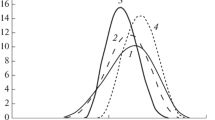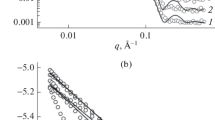Abstract
Human lens-lipid membranes prepared from the total lipids extracted from clear and cataractous lens cortexes and nuclei of 61–70-year-old donors by use of a rapid solvent-exchange method were investigated. The measured cholesterol-to-phospholipid (Chol/PL) molar ratio in these membranes was 1.8 and 4.4 for cortex and nucleus of clear lenses, respectively, and 1.14 and 1.45 for cataractous lenses. Properties and organization of the lipid bilayer were investigated by use of electron paramagnetic resonance spin-labeling methods. Formation of Chol crystals was confirmed by use of differential scanning calorimetry. Pure cholesterol bilayer domains (CBDs) were formed in all the membranes investigated. It was shown that in clear lens membranes of the nucleus, Chol exists in three different environments: (1) dispersed in phospholipid bilayers (PCDs), (2) in CBDs, and (3) in Chol crystals. In clear lens membranes of the cortex, and in cortical and nuclear cataractous lens membranes, Chol crystals were not detected, because of the lower Chol content. Profiles of membrane properties (alkyl-chain order, fluidity, oxygen transport, and hydrophobicity) across the PCD were very similar for clear and cataractous membranes. Profiles of the oxygen transport parameter across the CBD were, however, different for cortical clear and cataractous membranes—the amount and size of CBDs was less in cataractous membranes. These results suggest that high Chol content, formation of CBDs, and formation of Chol crystals should not be regarded as major predispositions for the development of age-related cataracts.







Similar content being viewed by others
References
Bach D, Wachtel E (2003) Phospholipid/cholesterol model membranes: formation of cholesterol crystallites. Biochim Biophys Acta 1610:187–197
Benatti CR, Lamy MT, Epand RM (2008) Cationic amphiphiles and the solubilization of cholesterol crystallites in membrane bilayers. Biochim Biophys Acta 1778:844–853
Borchman D, Delamere NA, Cauley LA, Paterson CA (1989) Studies on the distribution of cholesterol, phospholipid and protein in the human and bovine lens. Lens Eye Toxic Res 6:703–724
Borchman D, Lamba OP, Yappert MC (1993) Structural characterization of lipid membranes from clear and cataractous human lenses. Exp Eye Res 57:199–208
Borchman D, Byrdwell WC, Yappert MC (1994) Regional and age-dependent differences in the phospholipid composition of human lens membranes. Invest Ophthalmol Vis Sci 35:3938–3942
Borchman D, Cenedella RJ, Lamba OP (1996) Role of cholesterol in the structural order of lens membrane lipids. Exp Eye Res 62:191–197
Buboltz JT (2009) A more efficient device for preparing model-membrane liposomes by the rapid solvent exchange method. Rev Sci Instrum 80:124301
Buboltz JT, Feigenson GW (1999) A novel strategy for the preparation of liposomes: rapid solvent exchange. Biochim Biophys Acta 1417:232–245
Cenedella RJ (1996) Cholesterol and cataracts. Surv Ophthalmol 40:320–337
de Vries AC, Cohen LH (1993) Different effects of the hypolipidemic drugs pravastatin and lovastatin on the cholesterol biosynthesis of the human ocular lens in organ culture and on the cholesterol content of the rat lens in vivo. Biochim Biophys Acta 1167:63–69
Deeley JM, Mitchell TW, Wei X, Korth J, Nealon JR, Blanksby SJ, Truscott RJ (2008) Human lens lipids differ markedly from those of commonly used experimental animals. Biochim Biophys Acta 1781:288–298
Devaux PF (1983) ESR and NMR studies of lipid-protein interactions in membranes. In: Berliner LJ, Reuben J (eds) Biological magnetic resonance. Plenum Press, New York, pp 183–299
Epand RM (2003) Cholesterol in bilayers of sphingomyelin or dihydrosphingomyelin at concentrations found in ocular lens membranes. Biophys J 84:3102–3110
Estrada R, Yappert MC (2004) Regional phospholipid analysis of porcine lens membranes by matrix-assisted laser desorption/ionization time-of-flight mass spectrometry. J Mass Spectrom 39:1531–1540
Folch J, Lees M, Sloane Stanley GH (1957) A simple method for the isolation and purification of total lipids from animal tissues. J Biol Chem 226:497–509
Huang J, Buboltz JT, Feigenson GW (1999) Maximum solubility of cholesterol in phosphatidylcholine and phosphatidylethanolamine bilayers. Biochim Biophys Acta 1417:89–100
Huang L, Grami V, Marrero Y, Tang D, Yappert MC, Rasi V, Borchman D (2005) Human lens phospholipid changes with age and cataract. Invest Ophthalmol Vis Sci 46:1682–1689
Jacob RF, Cenedella RJ, Mason RP (1999) Direct evidence for immiscible cholesterol domains in human ocular lens fiber cell plasma membranes. J Biol Chem 274:31613–31618
Jacob RF, Cenedella RJ, Mason RP (2001) Evidence for distinct cholesterol domains in fiber cell membranes from cataractous human lenses. J Biol Chem 276:13573–13578
Kawasaki K, Yin J-J, Subczynski WK, Hyde JS, Kusumi A (2001) Pulse EPR detection of lipid exchange between protein rich raft and bulk domains in the membrane: methodology development and its application to studies of influenza viral membrane. Biophys J 80:738–748
Kirby TJ (1967) Cataracts produced by triparanol. (MER-29). Trans Am Ophthalmol Soc 65:494–543
Kusumi A, Subczynski WK, Hyde JS (1982) Oxygen transport parameter in membranes as deduced by saturation recovery measurements of spin-lattice relaxation times of spin labels. Proc Natl Acad Sci USA 79:1854–1858
Lai CL, Shau WY, Chang CH, Chen MF, Lai MS (2013) Statin use and cataract surgery: a nationwide retrospective cohort study in elderly ethnic Chinese patients. Drug Saf 36:1017–1024
Leuschen J, Mortensen EM, Frei CR, Mansi EA, Panday V, Mansi I (2013) Association of statin use with cataracts: a propensity score-matched analysis. JAMA Ophthalmol 131:1427–1434
Li LK, So L, Spector A (1985) Membrane cholesterol and phospholipid in consecutive concentric sections of human lenses. J Lipid Res 26:600–609
Li LK, So L, Spector A (1987) Age-dependent changes in the distribution and concentration of human lens cholesterol and phospholipids. Biochim Biophys Acta 917:112–120
Loomis CR, Shipley GG, Small DM (1979) The phase behavior of hydrated cholesterol. J Lipid Res 20:525–535
Machan CM, Hrynchak PK, Irving EL (2012) Age-related cataract is associated with type 2 diabetes and statin use. Optom Vis Sci 89:1165–1171
Mailer C, Nielsen RD, Robinson BH (2005) Explanation of spin-lattice relaxation rates of spin labels obtained with multifrequency saturation recovery EPR. J Phys Chem A 109:4049–4061
Mainali L, Feix JB, Hyde JS, Subczynski WK (2011a) Membrane fluidity profiles as deduced by saturation-recovery EPR measurements of spin-lattice relaxation times of spin labels. J Magn Reson 212:418–425
Mainali L, Raguz M, Camenisch TG, Hyde JS, Subczynski WK (2011b) Spin-label saturation-recovery EPR at W-band: applications to eye lens-lipid membranes. J Magn Reson 212:86–94
Mainali L, Raguz M, O’Brien WJ, Subczynski WK (2012a) Properties of fiber cell plasma membranes isolated from the cortex and nucleus of the porcine eye lens. Exp Eye Res 97:117–129
Mainali L, Raguz M, Subczynski WK (2012b) Phases and domains in sphingomyelin-cholesterol membranes: structure and properties using EPR spin-labeling methods. Eur Biophys J 41:147–159
Mainali L, Hyde JS, Subczynski WK (2013a) Using spin-label W-band EPR to study membrane fluidity profiles in samples of small volume. J Magn Reson 226:35–44
Mainali L, Raguz M, O’Brien WJ, Subczynski WK (2013b) Properties of membranes derived from the total lipids extracted from the human lens cortex and nucleus. Biochim Biophys Acta 1828:1432–1440
Mainali L, Raguz M, Subczynski WK (2013c) Formation of cholesterol bilayer domains precedes formation of cholesterol crystals in cholesterol/dimyristoylphosphatidylcholine membranes: EPR and DSC studies. J Phys Chem B 117:8994–9003
Mainali L, Sidabras JW, Camenisch TG, Ratke JJ, Raguz M, Hyde JS, Subczynski WK (2014) Spin-label W-band EPR with seven-loop–six-gap resonator: application to lens membranes derived from eyes of a single donor. Appl Magn Reson 45:1343–1358
Marsh D (1981) Electron spin resonance: spin labels. In: Grell E (ed) Membrane spectroscopy. Springer, Berlin, pp 51–142
Mason RP, Jacob RF (2003) Membrane microdomains and vascular biology. Emerging role in atherogenesis. Circulation 107:2270–2273
Mason R, Tulenko TN, Jacob RF (2003) Direct evidence for cholesterol crystalline domains in biological membranes: role in human pathobiology. Biochim Biophys Acta 1610:198–207
Mosley ST, Kalinowski SS, Schafer BL, Tanaka RD (1989) Tissue-selective acute effects of inhibitors of 3-hydroxy-3-methylglutaryl coenzyme A reductase on cholesterol biosynthesis in lens. J Lipid Res 30:1411–1420
Paterson CA, Zeng J, Husseini Z, Borchman D, Delamere NA, Garland D, Jimenez-Asensio J (1997) Calcium ATPase activity and membrane structure in clear and cataractous human lenses. Curr Eye Res 16:333–338
Plesnar E, Subczynski WK, Pasenkiewicz-Gierula M (2012) Saturation with cholesterol increases vertical order and smoothes the surface of the phosphatidylcholine bilayer: a molecular simulation study. Biochim Biophys Acta 1818:520–529
Raguz M, Widomska J, Dillon J, Gaillard ER, Subczynski WK (2008) Characterization of lipid domains in reconstituted porcine lens membranes using EPR spin-labeling approaches. Biochim Biophys Acta 1778:1079–1090
Raguz M, Widomska J, Dillon J, Gaillard ER, Subczynski WK (2009) Physical properties of the lipid bilayer membrane made of cortical and nuclear bovine lens-lipids: EPR spin-labeling studies. Biochim Biophys Acta 1788:2380–2388
Raguz M, Mainali L, Widomska J, Subczynski WK (2011a) The immiscible cholesterol bilayer domain exists as an integral part of phospholipid bilayer membranes. Biochim Biophys Acta 1808:1072–1080
Raguz M, Mainali L, Widomska J, Subczynski WK (2011b) Using spin-label electron paramagnetic resonance (EPR) to discriminate and characterize the cholesterol bilayer domain. Chem Phys Lipids 164:819–829
Raguz M, Mainali L, O’Brien WJ, Subczynski WK (2014) Lipid-protein interactions in plasma membranes of fiber cells isolated from the human eye lens. Exp Eye Res 120:138–151
Robinson BH, Haas DA, Mailer C (1994) Molecular dynamics in liquids: spin-lattice relaxation of nitroxide spin labels. Science 263:490–493
Rujoi M, Jin J, Borchman D, Tang D, Yappert MC (2003) Isolation and lipid characterization of cholesterol-enriched fractions in cortical and nuclear human lens fibers. Invest Ophthalmol Vis Sci 44:1634–1642
Schreier S, Polnaszek CF, Smith IC (1978) Spin labels in membranes. Problems in practice. Biochim Biophys Acta 515:395–436
Shaikh SR, Cherezov V, Caffrey M, Soni SP, LoCascio D, Stillwell W, Wassall SR (2006) Molecular organization of cholesterol in unsaturated phosphatidylethanolamines: X-ray diffraction and solid state 2H NMR reveal differences with phosphatidylcholines. J Am Chem Soc 128:5375–5383
Subczynski WK, Hyde JS, Kusumi A (1989) Oxygen permeability of phosphatidylcholine-cholesterol membranes. Proc Natl Acad Sci USA 86:4474–4478
Subczynski WK, Hyde JS, Kusumi A (1991) Effect of alkyl chain unsaturation and cholesterol intercalation on oxygen transport in membranes: a pulse ESR spin labeling study. Biochemistry 30:8578–8590
Subczynski WK, Hopwood LE, Hyde JS (1992) Is the mammalian cell plasma membrane a barrier to oxygen transport? J Gen Physiol 100:69–87
Subczynski WK, Wisniewska A, Yin J-J, Hyde JS, Kusumi A (1994) Hydrophobic barriers of lipid bilayer membranes formed by reduction of water penetration by alkyl-chain unsaturation and cholesterol. Biochemistry 33:7670–7681
Subczynski WK, Felix CC, Klug CS, Hyde JS (2005) Concentration by centrifugation for gas exchange EPR oximetry measurements with loop-gap resonators. J Magn Reson 176:244–248
Subczynski WK, Raguz M, Widomska J (2010) Studying lipid organization in biological membranes using liposomes and EPR spin labeling. Methods Mol Biol 606:247–269
Subczynski WK, Raguz M, Widomska J, Mainali L, Konovalov A (2012) Functions of cholesterol and the cholesterol bilayer domain specific to the fiber-cell plasma membrane of the eye lens. J Membr Biol 245:51–68
Tulenko TN, Chen M, Mason PE, Mason RP (1998) Physical effects of cholesterol on arterial smooth muscle membranes: evidence of immiscible cholesterol domains and alterations in bilayer width during atherogenesis. J Lipid Res 39:947–956
Widomska J, Raguz M, Dillon J, Gaillard ER, Subczynski WK (2007) Physical properties of the lipid bilayer membrane made of calf lens lipids: EPR spin labeling studies. Biochim Biophys Acta 1768:1454–1465
Yappert MC, Borchman D (2004) Sphingolipids in human lens membranes: an update on their composition and possible biological implications. Chem Phys Lipids 129:1–20
Yappert MC, Rujoi M, Borchman D, Vorobyov I, Estrada R (2003) Glycero- versus sphingo-phospholipids: correlations with human and non-human mammalian lens growth. Exp Eye Res 76:725–734
Yin JJ, Subczynski WK (1996) Effects of lutein and cholesterol on alkyl chain bending in lipid bilayers: a pulse electron spin resonance spin labeling study. Biophys J 71:832–839
Zelenka PS (1984) Lens lipids. Curr Eye Res 3:1337–1359
Acknowledgments
This work was supported by grants EY015526, EB002052, EB001980, and EY001931 from the National Institutes of Health. We acknowledge the help of Bhavna Sheth, MD.
Author information
Authors and Affiliations
Corresponding author
Rights and permissions
About this article
Cite this article
Mainali, L., Raguz, M., O’Brien, W.J. et al. Properties of membranes derived from the total lipids extracted from clear and cataractous lenses of 61–70-year-old human donors. Eur Biophys J 44, 91–102 (2015). https://doi.org/10.1007/s00249-014-1004-7
Received:
Revised:
Accepted:
Published:
Issue Date:
DOI: https://doi.org/10.1007/s00249-014-1004-7




